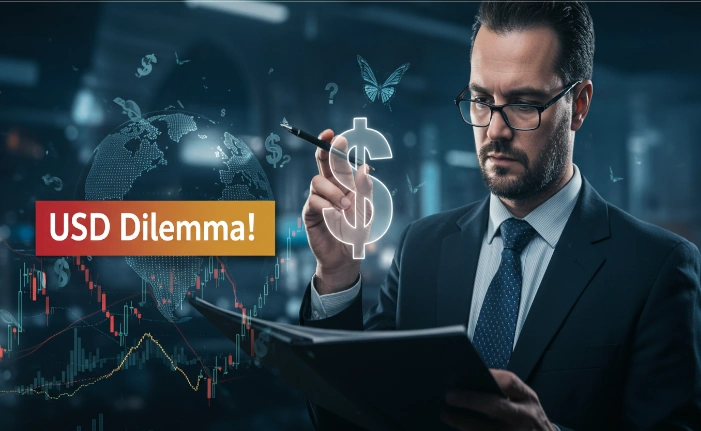The US Dollar Dilemma – A Butterfly in the Forex Forecast
Imagine the Dollar as a giant alligator, lounging in the swamp of global currencies. Its size and strength make it a force to be reckoned with. The US Dollar. It’s the undisputed heavyweight champion of the foreign exchange (forex) ring. But like any champ, its dominance has a ripple effect, creating a unique set of challenges for forex traders. Let’s call it the Dollar Dilemma, a butterfly flapping its wings in one corner of the world and causing a financial hurricane halfway across the globe. But for forex traders, the Dollar’s dominance presents a unique dilemma – a tango of opportunity and challenge.

Let’s delve into this “Dollar Dilemma,” exploring some lesser-discussed aspects of its impact.
The Denominator Effect
Most currency pairs are quoted against the dollar. This makes the US economy a constant reference point, but it also creates a bias. Imagine a seesaw where the dollar is always on one end. A strong dollar might indicate weakness in another currency, but it could also simply reflect the dollar’s own strength. This can mask underlying trends in other economies, making forex analysis more intricate.
The Paradox of Safety
The dollar is often seen as a safe haven during economic turmoil. Investors flock to it, driving its value up. This can be great for US exporters, whose goods become cheaper in foreign markets. However, for emerging economies, a strong dollar can be a curse. It makes their imports more expensive, hindering growth and potentially sparking financial instability.
The Albatross of Attraction
The dollar’s strength is a double-edged sword. It attracts foreign investment, seeking stability and the safety of the world’s reserve currency. This influx, however, can make the dollar appreciate. Suddenly, US exports become more expensive, dampening economic growth. Forex traders watching this unfold face a tricky situation. Do they ride the wave of a strengthening dollar, or anticipate a potential correction to capitalize on cheaper exports later?
The Great Carry Trade Caper

Another twist in the Dollar Dilemma is the carry trade. This strategy involves borrowing in a low-interest-rate currency (often the dollar) and investing it in a high-interest-rate one. It’s like a financial arbitrage, profiting from the interest rate differential. But here’s the catch: if the dollar strengthens unexpectedly, traders can face margin calls, forcing them to sell their higher-yielding assets at a loss. This sudden shift can ripple through the market, creating volatility for forex traders.
The Algorithmic Autopilot
The rise of algorithmic trading has introduced a new dimension to the Dollar Dilemma. These algorithms rely on historical data, and with the dollar’s historical dominance, they often prioritize dollar-denominated trades. This can create a self-fulfilling prophecy, further strengthening the dollar’s position even when economic fundamentals suggest otherwise.
The Geopolitical Butterfly
The US dollar is not just an economic player, it’s a geopolitical tool. A strong dollar can project American power, but it can also strain relationships with allies whose exports suffer. The weaponization of the dollar becomes a delicate dance, balancing economic interests with international diplomacy.
The Energy Enigma
The US, a major oil importer, benefits from a weaker dollar. Cheaper oil translates to lower production costs and potentially boosts exports. However, this can wreak havoc on forex forecasts. A planned weakening of the dollar by the US Federal Reserve, for instance, could be countered by global oil price fluctuations (The Petrodollar), throwing a wrench into forex trading strategies.
The Social Butterfly Effect
The Dollar Dilemma extends beyond economics. A strong dollar can make travel to the US cheaper for foreigners, impacting tourism-dependent economies. Conversely, a weak dollar can lead to inflation in import-reliant countries, squeezing household budgets. These social factors, often unforeseen, can create unforeseen consequences in the forex market.
The Technological Tap Dance
Now, enter the Technological Tap Dance. Innovations like cryptocurrencies have emerged, challenging the dollar’s long-held dominance. While their future remains uncertain, they represent a potential shift in how value is stored and exchanged. Forex traders who can anticipate these technological disruptions and their impact on the dollar’s role will be at an advantage.
The Climate Change Sway
The world also faces the Climate Change Sway. Environmental instability can trigger economic crises in vulnerable regions, impacting global trade and investment flows. The dollar’s role as a safe haven could be called into question if the US itself is perceived as highly susceptible to climate disruptions. Here, forex traders who factor in climate-related risks will be better positioned to navigate potential market swings.
The Unforeseen Forecast
The Dollar Dilemma reminds us that forex trading isn’t just about numbers on a screen. It’s a complex ecosystem where a central bank’s decision in Washington can lead to social unrest in Jakarta, all impacting a trader’s call in London.
The Dollar Dilemma isn’t a permanent state of affairs. The rise of other economic powerhouses like China and the European Union could lead to a multipolar forex system. This would create a more dynamic and potentially less predictable market, requiring forex traders to adapt their strategies.
The US dollar’s dominance may seem unshakeable, but its impact on the forex market is a complex dance. By understanding the Dollar Dilemma and its various facets, traders can gain a deeper understanding of the forces shaping the ever-evolving forex phere.

